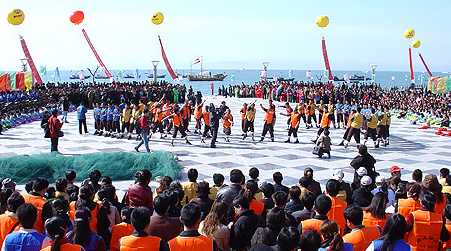Municipal ICH-Yao Da Lu
Yao Da Lu (row big oar), a folk dance popular with fishermen of Liuhe river in Taicang, was performed in temple fairs in the olden days.
It spread widely in regions of rivers and lakes among boat people. It stemmed from the monotonous lives of fishermen and boatmen and brought them entertainment.

The folk dance was introduced to the Liuhe area in the early 1930s by Yang Zhongmin, a folk artisan engaged in the transportation business in Yanggangjing at the border of Jiangsu and Zhejiang provinces. Yang saw the program in a temple fair. He was highly interested in the dance and introduced it at home. It was performed at a party celebrating the victory of the anti-Japanese Invasion War in 1945.
The dance can be performed by a man (stretch the sail) and a woman (grip the oar), in which the man acts as a clown or a scholar and flirts with the boat woman. It may also be played by three to six people. The characters wore different costumes with cattail leaf fans and big oars as stage props.
The folk dance is best known for its entertaining and comic nature. The characters are highly expressive and they make fun of each other in tacit cooperation. They sing as they row forward and change the lyrics whenever they pass by a shop. These impromptu lyrics are based on the trade of the shops and are often very humorous.
The dance reproduces the labor scenes of fishermen and boatmen and has high historical and aesthetic value. It is a unique style of folk dance. Since fishermen of the old generation have grown old and the older sail boats are increasingly being replaced by engine-driven vessels, Yao Da Lu has gradually been forgotten. This art form will perish in the near future if no efforts are paid to protect it.









